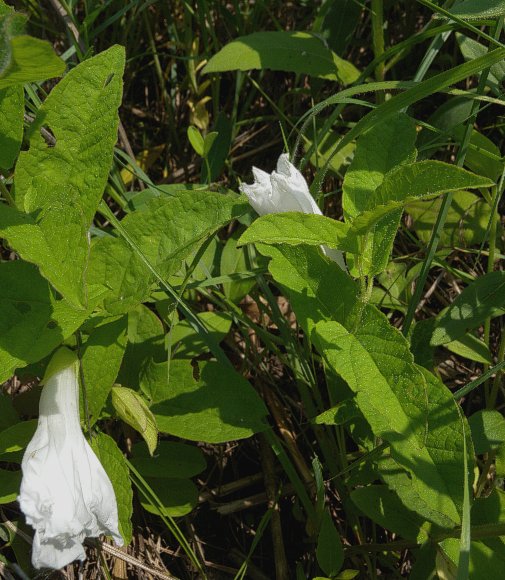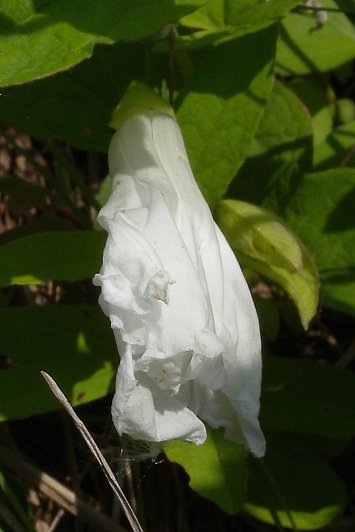Description: This perennial plant is ¾-1½' tall and unbranched. It is usually erect, but sometimes sprawls across the ground. The central stem is light green and hairy; it rarely twines about the stems of adjacent plants, fences, or other objects. Alternate leaves about 1½-3" long and about one-half as much across occur along the central stem. They are yellowish green to dull green, oblong-cordate in shape, smooth along their margins, and slightly to moderately hairy. The leaf bases are usually cordate (less often truncate or rounded), while their tips are blunt or pointed. Each leaf usually has a short petiole about ½" long or less; sometimes the upper leaves are sessile. Occasionally, individual flowers develop from the axils of the leaves; there are 1-4 flowers per plant. Each flower is about 2-3" long and 2" across, consisting of a white (rarely pink) funnelform corolla with 5 shallow lobes, 5 light green sepals, several stamens, and a pistil with 2 white stigmata. At the base of the flower, 2 sepal-like bracts surround the sepals; these bracts are light green and ovate. The pedicel is 1" long or less.

The blooming
period occurs from late spring to mid-summer and lasts about 1-2
months. On any given day, only 0-1 flowers are in bloom per plant. Each
large flower opens up during the early morning and closes at around
noon; it lasts only a single day. Fertilized flowers are replaced by
globoid seed capsules; each capsule is 2-celled and about 1/3" across.
Each cell of the capsule contains a single large seed. The root system
is rhizomatous, occasionally forming vegetative offsets.
Cultivation:
The preference is full sun, dry conditions, and soil containing sand,
rocky material, or clay.
Range & Habitat:
The native Erect Bindweed is found primarily in central and northern
Illinois, where it is uncommon (see Distribution
Map).
Populations of this species have
declined across the state. Habitats consist of upland
sand prairies, gravel prairies, hill prairies, open rocky
woodlands, limestone glades, and roadside embankments. Erect Bindweed
tends to increase in response to occasional wildfires as this reduces
woody vegetation and excess debris. This is an indicator plant of high
quality prairies.

Faunal Associations: Little is known about floral-faunal relationships for Erect Bindweed, although there is some information available about its more weedy relatives, e.g. Calystegia sepium (Hedge Bindweed). The flowers are cross-pollinated primarily by miscellaneous long-tongued bees. The caterpillars of Agrius cingulatus (Pink-Spotted Hawk Moth) require bindweed as a food source; the caterpillars of Emmelina monodactyla (Common Plume Moth) and Bedellia somnulentella (Morning Glory Leafminer) also feed on the foliage of species in the Bindweed family. Several beetles feed on the foliage and other parts of these same species: Typophorus nigritus (Sweet Potato Leaf Beetle), Strongylocassis atripes and other tortoise beetles, Chaetocnema confinis (Sweet Potato Flea Beetle), the stem-boring beetle Phaea monostigma, and the seed weevil Megacerus discoidus. One insect, Charidotella sexpunctata (Golden Tortoise Beetle), has been found on the foliage of Erect Bindweed specifically. There are also records of upland gamebirds eating the seeds of bindweed species: the Bobwhite, Ring-Necked Pheasant, and Prairie Chicken.

Photographic
Location:
The Coneflower Hill Prairie near Lake Shelbyville in Moultrie County,
Illinois. The flowers are mostly closed because the photograph was
taken after the blooming period during the morning.
Comments:
Unlike Erect Bindweed, most species in the Bindweed family are long
twining vines that are adapted to thickets, overgrown meadows, and
similar habitats. Most of these species are weedy annuals, although Ipomoea
pandurata (Wild Sweet Potato) is a perennial with a tuberous
swollen root. Species that are twining vines produce large showy
flowers in abundance. While the flowers of Erect Bindweed are also
large and showy, they are sparingly produced. All of these species have
short-lived flowers that remain open during the morning of a single
day. Other common names of Calystegia spithamaea
are Dwarf Bindweed, Low Bindweed, and Low False Bindweed. An older
scientific name of this species is Convolvulus spithamaeus.